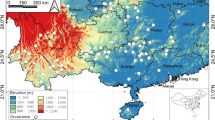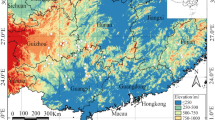Abstract
Climate change over the past decades has significantly altered global hydrothermal conditions and caused an evident shift in species distribution. Predicting species distribution patterns and identifying their influencing factors will be essential in developing coping strategies to prevent species extirpation and extinction. Yet, environmental factors affecting the distribution of woody species in Central Asia remain largely unknown. Here, I used the MaxEnt model to predict the current distributions and future distribution under three SSP-RCP scenarios of six common woody species in Central Asia. The results indicated a good performance of the MaxEnt model. Precipitation of driest month and annual mean temperature were the dominant factors affecting species distribution. For the species with wide ecological niches, i.e., Acer negundo and Rosa chinensis, the suitable areas showed an evident expansion trend under future scenarios. In addition, a trend toward higher elevation was found for the species that grew at high altitudes (1600–3200 m). However, the average elevation of suitable area for A. negundo and R. chinensis firstly increased but then decreased under future scenarios. Even though the areas with high species diversity increased from 0.59% under the current situation to 0.82% and 0.81% under ssp245 in 2021–2040 and 2041–2060, respectively, species diversity showed an apparent loss in parts of the northwest and southeast areas under ssp370 and ssp585. This study can guide susceptible habitat protections under climate change.







Similar content being viewed by others
References
Abolmaali SMR, Tarkesh M, Bashari H (2018) MaxEnt modeling for predicting suitable habitats and identifying the effects of climate change on a threatened species, Daphne mucronata, in central Iran. Eco Inform 43:116–123
Arend M, Brem A, Kuster TM et al (2013) Seasonal photosynthetic responses of European oaks to drought and elevated daytime temperature. Plant Biol 15(Suppl 1):169–176
Buse J, Boch S, Hilgersd J et al (2015) Conservation of threatened habitat types under future climate change-Lessons from plant-distribution models and current extinction trends in southern Germany. J Nat Conserv 27:18–25
Butchart SHM, Walpole M, Collen B et al (2010) Global biodiversity: indicators of recent declines. Science 328(5982):1164–1168
Carroll C, Johnson DS (2008) The importance of being spatial (and reserved): assessing northern spotted owl habitat relationships with hierarchical Bayesian models. Conserv Biol 22(4):1026–1036
Case MJ, Lawler JJ (2016) Integrating mechanistic and empirical model projections to assess climate impacts on tree species distributions in northwestern North America. Glob Change Biol 23(5):2005–2015
Chen IC, Hill JK, Ohlemuller R et al (2011) Rapid range shifts of species associated with high levels of climate warming. Science 333(6045):1024–1026
de Beurs KM, Henebry GM, Owsley BC et al (2018) Large scale climate oscillation impacts on temperature, precipitation and land surface phenology in Central Asia. Environ Res Lett 13(6):065018
Deng HY, Yin YH, Han X (2020) Vulnerability of vegetation activities to drought in Central Asia. Environ Res Lett 15(8):084005
Elith J, Graham CH, Anderson RP et al (2006) Novel methods improve prediction of species’ distributions from occurrence data. Ecography 29(2):129–151
Fick SE, Hijmans RJ (2017) WorldClim 2: new 1-km spatial resolution climate surfaces for global land areas. Int J Climatol 37(12):4302–4315
Fischer G, Nachtergaele F, Prieler S et al (2008) Global agro-ecological zones assessment for agriculture (GAEZ 2008). IIASA, Laxenburg, Austria and FAO, Rome, Italy, India
Gelviz-Gelvez SM, Pavon NP, Illoldi-Rangel P et al (2015) Ecological niche modeling under climate change to select shrubs for ecological restoration in Central Mexico. Ecol Eng 74:302–309
Hand DJ, Till RJ (2001) A simple generalisation of the area under the ROC curve for multiple class classification problems. Mach Learn 45(2):171–186
Harsch MA, HilleRisLambers J (2016) Climate warming and seasonal precipitation change interact to limit species distribution shifts across western North America. PLoS ONE 11(7):1–17
Jiao WZ, Wang LX, Smith WK et al (2021) Observed increasing water constraint on vegetation growth over the last three decades. Nat Commun 12(1):1–9
Johnson CA, Dutt P, Levine JM (2022) Competition for pollinators destabilizes plant coexistence. Nature 607:721–725
Kass JM, Muscarella R, Galante PJ et al (2021) ENMeval 2.0: redesigned for customizable and reproducible modeling of species’ niches and distributions. Methods Ecol Evol 12(9):1602–1608
Khanum R, Mumtaz AS, Kumar S (2013) Predicting impacts of climate change on medicinal asclepiads of Pakistan using Maxent modeling. Acta Oecologica 49:23–31
Körner C, Basler D, Hoch G et al (2016) Where, why and how? Explaining the low-temperature range limits of temperate tree species. J Ecol 104(4):1076–1088
Kreyling J, Schmid S, Aas G (2015) Cold tolerance of tree species is related to the climate of their native ranges. J Biogeogr 42(1):156–166
Li CY, Welling A, Puhakainen T et al (2005) Differential responses of silver birch (Betula pendula) ecotypes to short-day photoperiod and low temperature. Tree Physiol 25(12):1563–1569
Li GQ, Xu GH, Guo K et al (2016) Geographical boundary and climatic analysis of Pinus tabulaeformis in China: Insights on its afforestation. Ecol Eng 86:75–84
Ma YN, Lu XL, Li KW et al (2021) Prediction of potential geographical distribution patterns of actinidia arguta under different climate scenarios. Sustainability 13(6):1–14
Nature Climate Change (2019) The CMIP6 landscape. Nat Clim Chang 9(10):727–727
Ngarega BK, Masocha VF, Schneider H (2021) Forecasting the effects of bioclimatic characteristics and climate change on the potential distribution of Colophospermum mopane in southern Africa using Maximum Entropy (Maxent). Eco Inform 65:101419
Parmesan C (2006) Ecological and evolutionary responses to recent climate change. Annu Rev Ecol Evol Syst 37:637–669
Parmesan C, Yohe G (2003) A globally coherent fingerprint of climate change impacts across natural systems. Nature 421(6918):37–42
Phillips SJ, Anderson RP, Schapire RE (2006) Maximum entropy modeling of species geographic distributions. Ecol Model 190(3–4):231–259
Radosavljevic A, Anderson RP (2014) Making better Maxent models of species distributions: complexity, overfitting and evaluation. J Biogeogr 41(4):629–643
Root TL, Price JT, Hall KR et al (2003) Fingerprints of global warming on wild animals and plants. Nature 421(6918):57–60
Shabani F, Kumar L, Ahmadi M (2018) Assessing accuracy methods of species distribution models: AUC, specificity, sensitivity and the true skill statistic. Global J Human-Social Sci: B Geog, Geo-Sci, Environ Sci Disasters Manag 18(1):6–18
Steven JP, Miroslav D, Robert ES. (2022) [Internet] Maxent software for modeling species niches and distributions (Version 3.4.1). Available from URL: http://biodiversityinformatics.amnh.org/open_source/maxent/. Accessed on 2022–04–01.
Stratopoulos LMF, Zhang C, Haberle KH et al (2019) Effects of drought on the phenology, growth, and morphological development of three urban tree species and cultivars. Sustainability 11(18):1–15
Taiz L, Zeiger E (2006) Plant physiology. Sinauer Associates, Sunderland
Thuiller W (2004) Patterns and uncertainties of species’ range shifts under climate change. Glob Change Biol 10(12):2020–2027
Thuiller W, Lavorel S, Araújo MB et al (2005) Climate change threats to plant diversity in Europe. Proc Natl Acad Sci USA 102(23):8245–8250
Tian L (2018) Relationship between environmental factors and the spatial distribution of Spermophilus dauricus during 2000–2015 in China. Int J Biometeorol 62(10):1781–1789
Vitasse Y, Lenz A, Korner C (2014) The interaction between freezing tolerance and phenology in temperate deciduous trees. Front Plant Sci 5:1–12
Wang Z, Yuan X, Wang D et al (2018) Large herbivores influence plant litter decomposition by altering soil properties and plant quality in a meadow steppe. Sci Rep 8(1):9089
Warren DL, Seifert SN (2011) Ecological niche modeling in Maxent: the importance of model complexity and the performance of model selection criteria. Ecol Appl 21(2):335–342
Wu Z, Raven PH, Hong D (1994) Flora of China. Science Press, Beijing
Yang XQ, Kushwaha SPS, Saran S et al (2013) Maxent modeling for predicting the potential distribution of medicinal plant, Justicia adhatoda L. in Lesser Himalayan foothills. Ecol Eng 51:83–87
Yin G, Hu ZY, Chen X (2016) Vegetation dynamics and its response to climate change in Central Asia. J Arid Land 8(3):375–388
Zhang XZ, He M, Bai MX et al (2021) Meteorological drought and its large-scale climate patterns in each season in Central Asia from 1901 to 2015. Clim Change 166(3–4):1–18
Zhao JJ, Gong L (2021) Response of fine root carbohydrate content to soil nitrogen addition and its relationship with soil factors in a schrenk (Picea schrenkiana) forest. J Plant Growth Regul 40(3):1210–1221
Zhao HX, Zhang H, Xu CG (2020) Study on Taiwania cryptomerioides under climate change: MaxEnt modeling for predicting the potential geographical distribution. Global Ecol Conservation 24:e01313
Zhao Y, Deng XW, Xiang WH et al (2021) Predicting potential suitable habitats of Chinese fir under current and future climatic scenarios based on Maxent model. Eco Inform 64:101393
Zhu H, Chen J, Chen S (2019) Soil geography. Higher Education Press, Beijing
Funding
This work was funded by National Key R&D Program of China (Grant No. 2018YFA0606102), National Natural Science Foundation of China (Grant No. 41901014), and Strategic Priority Research Program of Chinese Academy of Sciences (Grant No. XDA20020202).
Author information
Authors and Affiliations
Corresponding author
Ethics declarations
Conflict of interest
The author declares no competing interests.
Supplementary Information
Below is the link to the electronic supplementary material.
Rights and permissions
Springer Nature or its licensor (e.g. a society or other partner) holds exclusive rights to this article under a publishing agreement with the author(s) or other rightsholder(s); author self-archiving of the accepted manuscript version of this article is solely governed by the terms of such publishing agreement and applicable law.
About this article
Cite this article
Tao, Z. Predicting the changes in suitable habitats for six common woody species in Central Asia. Int J Biometeorol 67, 107–119 (2023). https://doi.org/10.1007/s00484-022-02389-w
Received:
Revised:
Accepted:
Published:
Issue Date:
DOI: https://doi.org/10.1007/s00484-022-02389-w




